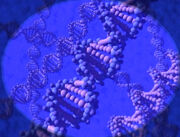mNo edit summary |
(Changed the tense of the article so that it is not past-tense; this implies that somehow the events of the many series(es?) happened in the past, and not in a future/present tense as they were intended to imply. Also added some specificity to 'alien') |
||
| Line 6: | Line 6: | ||
[[File:DNA.jpg|thumb|[[DNA]], the genetic programming of a lifeform]] |
[[File:DNA.jpg|thumb|[[DNA]], the genetic programming of a lifeform]] |
||
| − | A '''lifeform''' |
+ | A '''lifeform''' is simply any living entity or organism. The study of lifeforms is known as [[biology]], and, when dealing with [[alien]] (or rather, non-Terran) lifeforms, can be further sub-categorized into [[xenobiology]] and xenology. |
| − | [[Starship]] [[sensor]]s and [[tricorder]]s |
+ | [[Starship]] [[sensor]]s and [[tricorder]]s are primary instruments used in detecting or locating lifeforms, as they can identify or localize [[blood]] type, [[heart]] rate or metabolic setup. |
| − | A lifeform |
+ | A lifeform is not necessarily [[organic]] — which is to say [[carbon]]-based. Nevertheless, Federation [[scan]]s for lifeforms often looked only for organic life. In at least one known case, this limited view of what constituted a lifeform had disastrous consequences for a Federation [[terraforming]] project. ({{TNG|Home Soil}}) |
{{bginfo|There are incredible similarities between the lifeforms on different worlds in the ''Star Trek'' [[universe]]. A probable explanation for this may be the existence of the [[ancient humanoid]]s [[DNA]] during evolution.}} |
{{bginfo|There are incredible similarities between the lifeforms on different worlds in the ''Star Trek'' [[universe]]. A probable explanation for this may be the existence of the [[ancient humanoid]]s [[DNA]] during evolution.}} |
||
Revision as of 00:21, 26 June 2013
- "I just love scanning for lifeforms. Lifeforms... you tiny little lifeforms... you precious little lifeforms... where are you?"
- "Our mission as Starfleet officers is to seek out new lifeforms so we can learn about one another."
- - Miles O'Brien (DS9: "Captive Pursuit")

DNA, the genetic programming of a lifeform
A lifeform is simply any living entity or organism. The study of lifeforms is known as biology, and, when dealing with alien (or rather, non-Terran) lifeforms, can be further sub-categorized into xenobiology and xenology.
Starship sensors and tricorders are primary instruments used in detecting or locating lifeforms, as they can identify or localize blood type, heart rate or metabolic setup.
A lifeform is not necessarily organic — which is to say carbon-based. Nevertheless, Federation scans for lifeforms often looked only for organic life. In at least one known case, this limited view of what constituted a lifeform had disastrous consequences for a Federation terraforming project. (TNG: "Home Soil")
Starfleet lifeform classes and types
- Classification R-3 lifeforms (Sheliak)
- Class-5 lifeforms (Vhnori)
- Order 480-G anthropoids (Taurus II natives)
Kingdoms
Other types of life
- Artificial
- Biomimetic lifeform
- Cybernetic
- Silicon-based
- Solanogen-based
- Spaceborne
- Viral
- Xenon-based
- Sporocystian
See also
- Anatomy
- Non-sentient lifeforms
- Species and cultures
